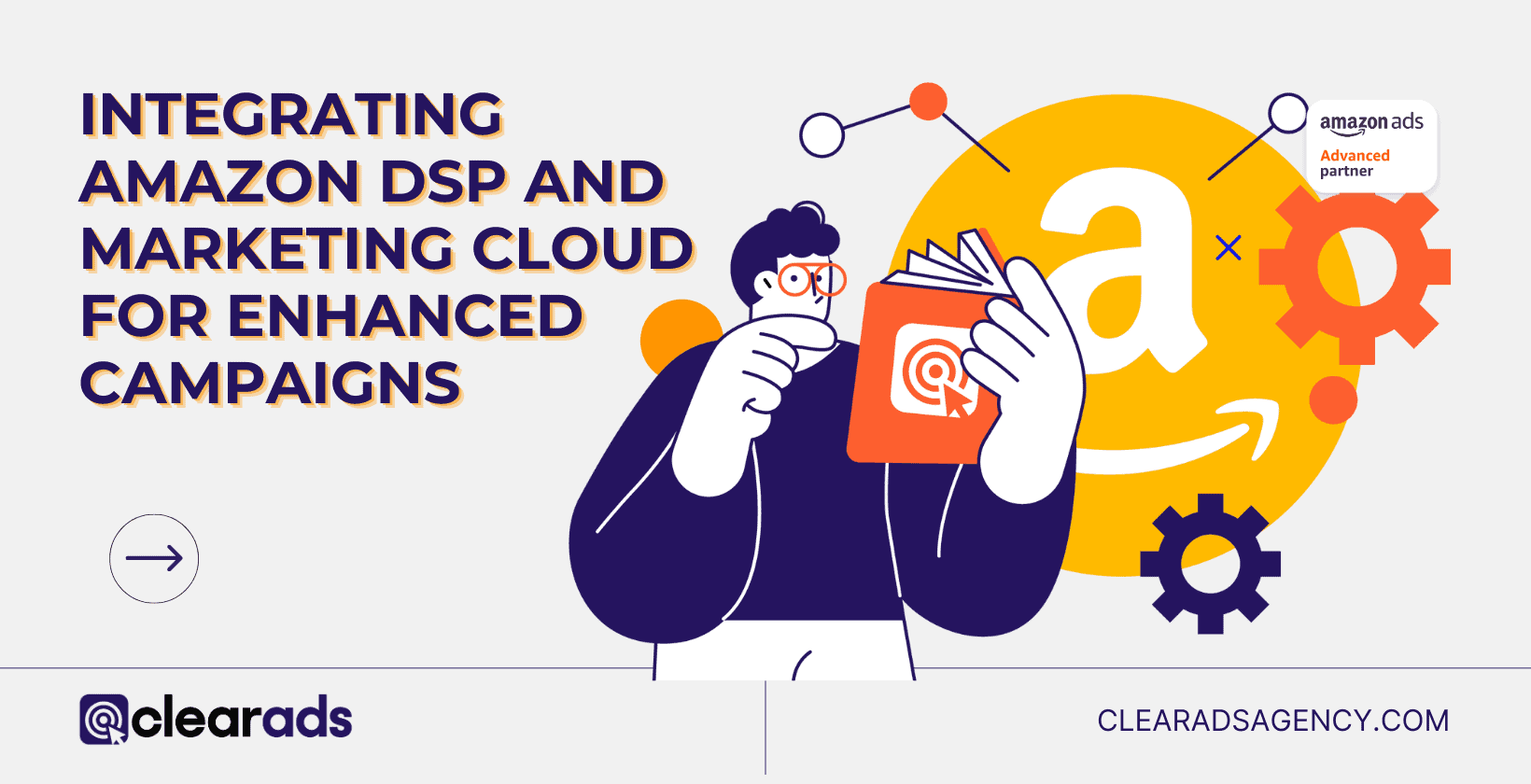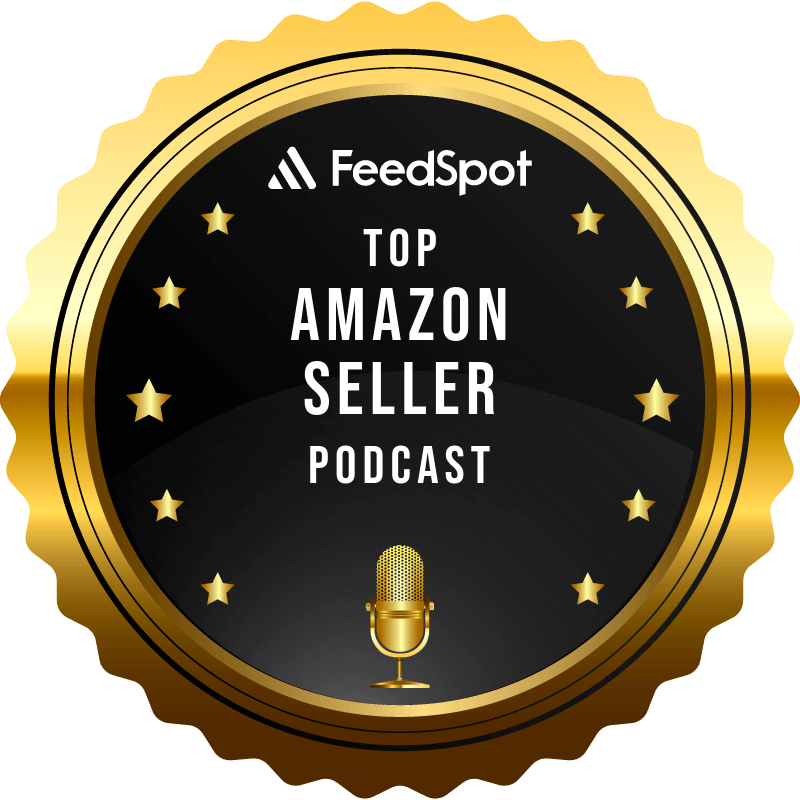Creative strategies and ad formats have evolved significantly since the early days of internet advertising in the 1990s. Initially, digital ads were simplistic, often text-based or basic banners. As technology advanced, especially post-2000, we witnessed a shift towards more interactive and visually compelling formats, such as rich media and video ads. Today, the focus is on harnessing data-driven insights for personalized advertising, utilizing advanced technologies like artificial intelligence and augmented reality to create engaging and immersive experiences. The evolution reflects a deeper understanding of consumer behavior and technological advancements, shaping how brands connect with their audiences in the digital space.
In this insightful exploration, we delve into the latest trends and innovative strategies in ad creative design, tailored for Amazon’s Demand Side Platform. As the digital realm evolves, so does the art of capturing consumer attention. From leveraging Amazon’s extensive data for hyper-personalized ads to embracing the concise power of short-form videos, and from the elegance of minimalist visuals to the immersive experiences of AR-enabled ads, we’re on the cusp of a transformative era. This journey through the latest trends not only highlights the importance of eco-friendly branding and the integration of audio in ads but also showcases the revolutionary impact of artificial intelligence in streamlining ad creation. Join us as we navigate these exciting developments, offering a glimpse into the future of digital ad creatives.
Amazon Demand-Side Platform (DSP) offers various ad formats to advertisers, enabling them to reach their target audience across Amazon-owned sites and apps, as well as a vast network of publishing partners. Incorporating Dynamic Creative Optimization (DCO) in DSP (Demand-Side Platform) ads represents a significant leap in digital advertising. Improving the effectiveness of Call-to-Action (CTA) elements in DSP (Demand-Side Platform) ad creatives is essential for driving user engagement and conversions. The latest trends in Amazon DSP ad creative design emphasize increased personalization using Amazon’s consumer data, interactive formats like polls and quizzes, short-form video storytelling, minimalist visual design, AR-enabled ads for immersive experiences, eco-friendly branding messages, audio elements to complement voice search technology, and the use of AI for efficient ad creative production. Creative development for DSP (Demand-Side Platform) advertising presents unique challenges, stemming from the complexities of digital platforms, audience diversity, and the dynamic nature of online advertising.
What Are the Various Ad Formats Available in Amazon DSP?
Amazon Demand-Side Platform (DSP) offers various ad formats to advertisers, enabling them to reach their target audience across Amazon-owned sites and apps, as well as a vast network of publishing partners.
Here are the 8 key ad formats available in Amazon DSP:
- Display Ads: These are the most common ad formats, including static or animated images that appear on websites, apps, and devices. They come in various sizes and can be placed in different sections of a webpage.
- Video Ads: Amazon DSP supports various video ad formats, including in-stream (such as pre-roll, mid-roll, and post-roll), out-stream (ads that appear outside of a video player), and OTT (Over-the-Top, which refers to video content served over the internet, bypassing traditional broadcast).
- Audio Ads: These ads are played to users who are streaming music or podcasts on Amazon-owned platforms like Amazon Music. They offer an auditory way to reach the audience.
- Mobile Ads: Specifically designed for mobile devices, these ads can appear within apps or on web pages accessed via mobile browsers. They can be tailored to leverage mobile-specific features like click-to-call.
- Connected TV (CTV) Ads: These ads appear on connected TV devices and are part of OTT advertising. They allow advertisers to reach viewers who are streaming content on smart TVs and connected devices.
- Custom Ads: Amazon DSP also offers the possibility of creating custom ad experiences, which can include interactive elements, custom creative designs, and unique placements that are tailored to the advertiser’s specific goals.
- Dynamic E-commerce Ads: These ads use Amazon’s e-commerce data to dynamically display products based on the user’s shopping behavior and preferences. They are highly relevant and can be used for retargeting campaigns.
- Sponsored Display Ads: A form of self-service advertising, these ads appear both on and off Amazon and are targeted based on shopper behaviors, offering simpler targeting and creative options compared to other DSP formats.
How to Choose the Right Ad Format for Your DSP Campaign?
The decision should be based on several factors, including your campaign goals, target audience, budget, and the nature of your product or service.
Here are some guidelines to help you select the appropriate ad format:
Define Your Campaign Goals:
- Brand Awareness: If your goal is to increase brand awareness, visually engaging formats like display and video ads are effective. These formats are good for storytelling and creating a memorable impact.
- Engagement: For engagement, interactive ad formats or video ads can be more effective as they encourage user interaction.
- Conversions: If your goal is to drive sales or specific actions, dynamic e-commerce ads and sponsored display ads can be more effective as they are directly linked to products and can be highly targeted based on user shopping behavior.
Understand Your Target Audience:
- Consider where your audience spends their time online and what type of content they consume. For instance, younger audiences might be more engaged with video content, while a more professional audience might respond better to detailed display ads.
Consider the Customer Journey:
- Different ad formats can be effective at different stages of the customer journey. For instance, use display ads for top-of-funnel awareness and video or dynamic e-commerce ads for middle or bottom-of-funnel conversion strategies.
Budget and Resources:
- Video and custom ads typically require a larger budget and more creative resources. Assess if you have the necessary resources to create high-quality content for these formats.
- Display and sponsored display ads might be more budget-friendly and easier to produce.
Evaluate the Context and Placement:
- Consider where your ads will be displayed. For instance, if you’re targeting audiences on mobile devices, mobile-optimized formats would be more suitable.
- Audio ads can be effective if you’re targeting users on platforms like Amazon Music.
Testing and Optimization:
- Regularly review campaign performance and be ready to adjust the ad format based on what is working.
Remember, the effectiveness of an ad format can vary greatly depending on the specifics of your campaign and audience. It’s often a process of testing and learning to determine the most effective approach for your particular needs.
Leveraging Rich Media and Video Ads in DSP for Higher Engagement
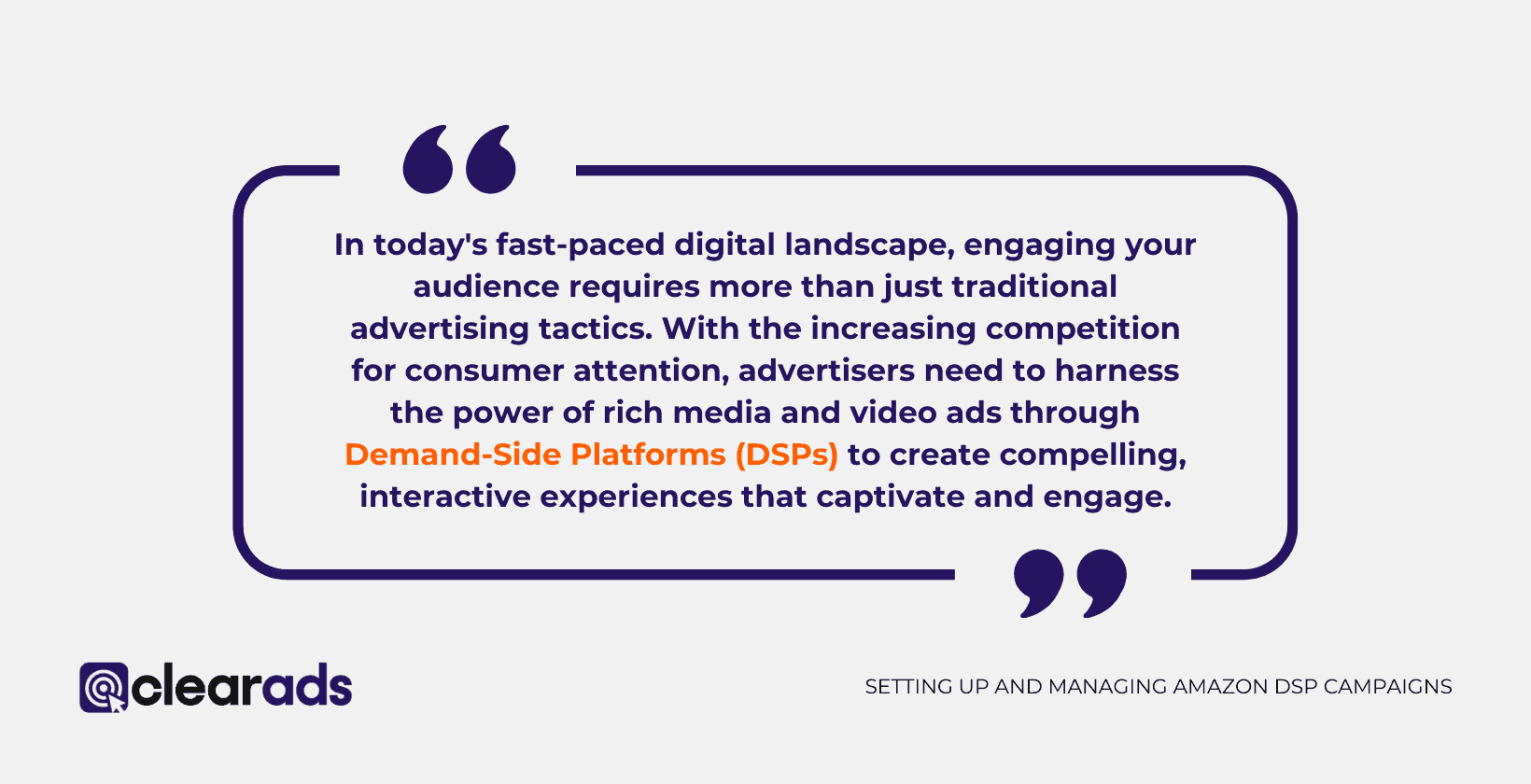
In today’s fast-paced digital landscape, engaging your audience requires more than just traditional advertising tactics. With the increasing competition for consumer attention, advertisers need to harness the power of rich media and video ads through Demand-Side Platforms (DSPs) to create compelling, interactive experiences that captivate and engage.
Rich media ads offer interactive features like animations, carousels, or embedded forms that can actively engage users, making them more likely to remember your brand and interact with your ad. Video ads, on the other hand, are storytelling powerhouses. They combine visual and auditory elements to evoke emotions, create narratives, and form a deeper connection with the audience.
The dynamic nature of rich media and video ads drives higher engagement rates compared to static ads. They are particularly effective in capturing user attention and fostering brand recall. By incorporating these formats in your DSP campaigns, you offer your audience an engaging and memorable experience that stands out in a crowded digital space.
DSPs enable precise targeting and personalization, which are key in maximizing the impact of rich media and video ads. You can tailor your content based on user behaviors, preferences, and demographics to ensure relevance. Personalized video content, for instance, can significantly boost click-through rates and conversions.
The beauty of using DSPs lies in their robust tracking and analytics capabilities. You can measure a range of metrics from viewability, and engagement rates, to conversion metrics, providing valuable insights into how your audience interacts with your ads. This data allows for continual optimization of your campaigns, ensuring that your rich media and video ads are not just creative but also effective in achieving your marketing objectives.
5 Best Practices for Implementation:
- Quality Content: Invest in high-quality, professional content that reflects your brand’s message and appeals to your target audience.
- Storytelling: Use storytelling in your video ads to create emotional connections with your audience.
- Call-to-Action: Include clear, compelling calls-to-action in your ads to guide users on what to do next.
- Mobile Optimization: Ensure your ads are optimized for mobile devices, as a significant portion of your audience will engage with your ads on these devices.
- Testing and Iteration: Regularly test different elements of your ads and use the data to refine and improve your approach.
Integrating rich media and video ads into your DSP campaigns is a powerful strategy to boost engagement and create a lasting impact. By leveraging the targeting and analytics power of DSPs, and focusing on quality, storytelling, and optimization, you can effectively capture your audience’s attention and drive meaningful results for your brand.
Designing Impactful Display Ads for Amazon DSP Campaigns
The design and message of your ads play a significant role in the success of your campaigns. Here’s a comprehensive guide to crafting display ads that resonate with your audience and enhance your brand presence. Before you design your ad, understand who you are targeting. What are their interests, online behavior, and purchasing habits? Amazon DSP provides rich data that can help you gain insights into your audience.
Refining and enhancing your ad content to engage your target demographic effectively involves several key elements:
Tailored Messaging:
- Personalize your ad content to resonate with your target audience.
- Utilize personalization strategies to significantly boost engagement and conversion rates.
Using High-Quality Images:
- Choose professional, high-resolution images that are relevant to your product or service.
- Quality visuals not only make your ad more appealing but also establish trustworthiness.
- Align your imagery with your brand’s aesthetic and values, ensuring consistent visual branding that aids in brand recognition and loyalty.
Incorporating Brand Identity:
- Make sure your brand’s logo is visible, and the color scheme mirrors your brand identity, reinforcing brand recall.
- The tone and language of your ad should be consistent with your overall brand voice, whether it’s professional, friendly, or quirky.
Crafting a Clear and Compelling Message:
- Keep your ad copy concise yet impactful. Clearly articulate your value proposition and what sets your product or service apart.
- Focus on highlighting the benefits your product or service offers, emphasizing how it can solve problems or enhance the customer’s life.
Including a Strong Call-to-Action (CTA):
- Your CTA should be straightforward, guiding the viewer on the next steps, such as ‘Shop Now’, ‘Learn More’, or ‘Sign Up’.
- Ensure your CTA is visually distinctive, standing out through color contrast or strategic placement.
Optimizing for Mobile Devices:
- Design with a mobile-first approach, considering the significant number of users accessing Amazon on mobile devices.
- Ensure that ads load quickly and are clear and legible, even on smaller screens.
Leveraging Amazon’s Data for Personalization:
- Take advantage of Amazon’s extensive customer data to target your ads more effectively, utilizing insights from past purchases, browsing history, and search patterns.
- Implement dynamic ads that adapt based on the viewer’s Amazon activity, creating a personalized and relevant ad experience for each user.
By focusing on these elements, you can create display ads that not only capture attention but also drive meaningful engagement and conversions. Remember, the goal is to blend creativity with data-driven insights to speak directly to your audience’s needs and desires, ultimately boosting the success of your Amazon DSP campaigns.
Incorporating Dynamic Creative Optimization in DSP Ads
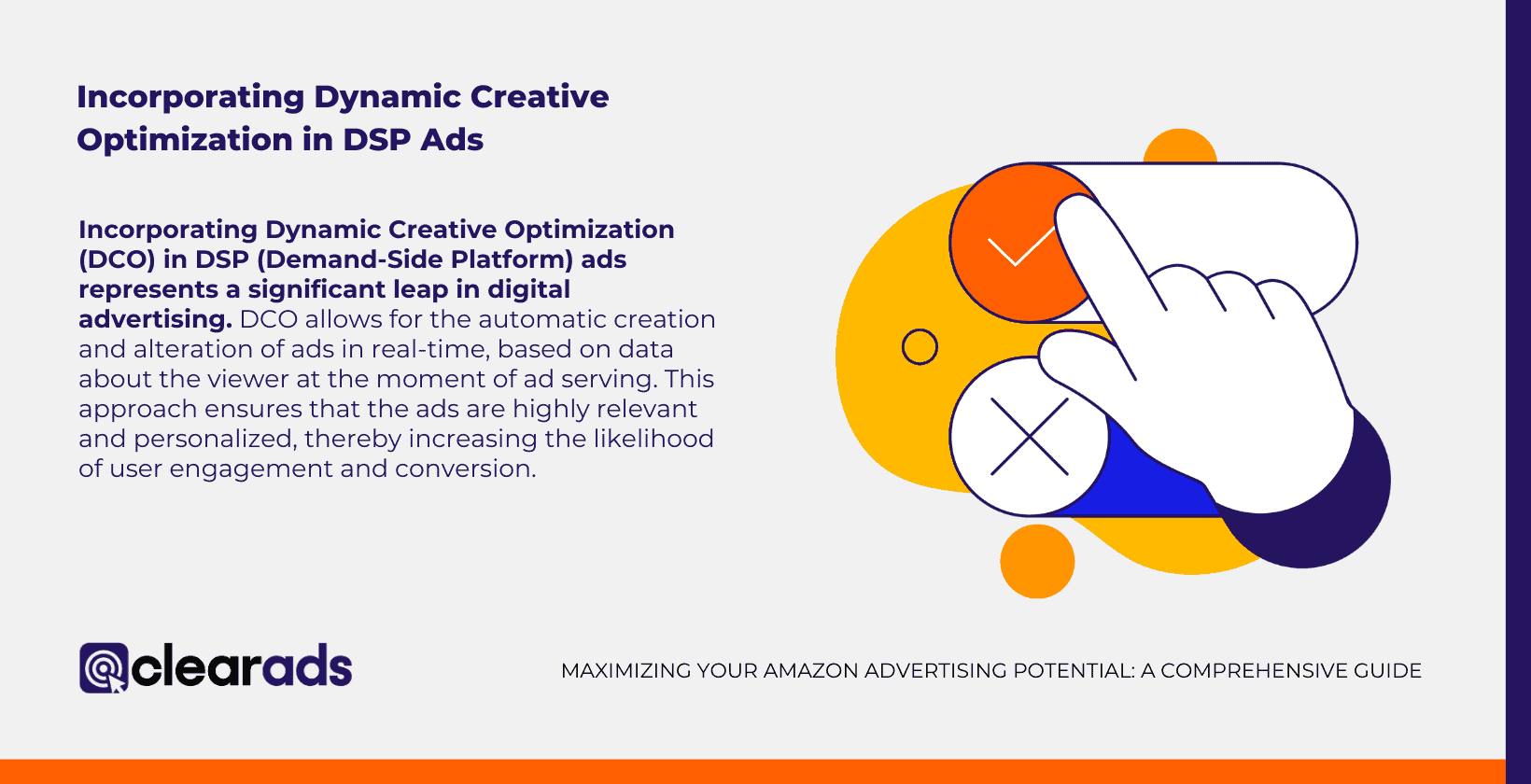
Incorporating Dynamic Creative Optimization (DCO) in DSP (Demand-Side Platform) ads represents a significant leap in digital advertising. DCO allows for the automatic creation and alteration of ads in real-time, based on data about the viewer at the moment of ad serving. This approach ensures that the ads are highly relevant and personalized, thereby increasing the likelihood of user engagement and conversion.
Dynamic Creative Optimization is a technology that combines rich data insights with creative advertising elements. It enables the creation of ads that are tailored to individual users based on their behavior, preferences, and other contextual factors. DCO uses real-time data like user’s browsing behavior, purchase history, demographic information, and more to dynamically adjust the creative elements of an ad. This could include changing images, text, or calls to action to better resonate with the viewer.
Benefits of Using DCO in DSP Ads:
- Increased Relevance and Engagement: Ads become more relevant to the user, as they are based on the user’s behavior and preferences.
- Improved Conversion Rates: Users are more likely to respond to an ad that feels specifically tailored to their needs and interests.
- Efficiency and Scalability: DCO automates much of the creative process, allowing for the rapid creation and deployment of varied ad experiences. This scalability means you can reach a broader audience with personalized messaging without requiring numerous individual ad creatives.
- Real-Time Optimization: DCO allows for ads to be optimized in real-time, constantly refining the creative elements based on ongoing user data and interaction feedback.
The first step is to collect and analyze data that will inform the DCO. This includes understanding audience segments, their behavior, preferences, and the kind of content that resonates with them.
Create ad templates that are flexible enough to accommodate dynamic content changes. This means having placeholders for images, text, and other elements that can be automatically replaced. Define the rules and parameters that will dictate how the ad content should change. For example, if a user has previously viewed a particular product, the ad might display that product or related items dynamically.
Continuously test and optimize your DCO strategies. A/B testing can be particularly effective in understanding what combinations of creative elements work best.
Incorporating DCO into your DSP ads can significantly enhance the effectiveness of your digital advertising efforts. By creating ads that are not just audience-specific but individual-specific, advertisers can engage with their audience in a more meaningful and impactful way.
The Role of Creative Testing in Enhancing DSP Ad Performance
Creative testing plays a pivotal role in enhancing DSP (Demand-Side Platform) ad performance. In the digital advertising landscape, where consumer preferences and market dynamics are constantly evolving, testing various creative elements of your ads is crucial for understanding what resonates best with your target audience. Creative testing involves experimenting with different versions of an ad to determine which performs better based on predefined metrics like click-through rates, conversion rates, or engagement levels.
Through creative testing, you can identify which elements of your ad (such as images, headlines, call-to-actions, or overall design) are most effective at capturing attention and driving action. Testing allows for a deeper understanding of what appeals to different segments of your audience, leading to more personalized and relevant ad experiences.
By determining which ad variations perform the best, you can allocate your budget more effectively, maximizing the ROI on your ad spend.
Steps in Creative Testing for DSP Ads:
- Develop Multiple Ad Variations
- Establish clear KPIs (Key Performance Indicators)
- Use A/B Testing and Multivariate Testing:
- Leverage DSP’s Targeting and Segmentation:
- Analyze Results and Gather Insights:
- Iterate Based on Learnings
Use the insights gained from testing to refine and optimize future ad creatives. This should be an ongoing process, where learnings from each test are applied to continually improve ad performance. The digital advertising environment is dynamic, and what works today may not be as effective tomorrow. Continuous creative testing is essential to stay ahead of changing consumer trends and technological advancements.
Regular testing helps in:
- Keeping the content fresh and engaging.
- Adapting to shifting market trends and consumer preferences.
- Leveraging new features and formats that emerge within DSP platforms.
In conclusion, creative testing is not just a one-time activity but a fundamental aspect of a successful DSP advertising strategy. It empowers advertisers to make data-driven decisions, ensuring that their ads are not only creative and eye-catching but also finely tuned to resonate with their target audience, ultimately driving better performance and ROI.
Best Practices for Crafting Creative Copy in DSP Ads
Crafting creative copy for DSP (Demand-Side Platform) ads is both an art and a science. It requires creativity, strategic thinking, and a deep understanding of your target audience and platform capabilities.
Here are some best practices to help you create compelling ad copy that resonates with your audience and drives results in your DSP campaigns:
Crafting effective ad copy for DSP (Demand-Side Platform) requires a blend of strategy, creativity, and attention to detail. Start by deeply understanding your audience, including both demographics and psychographics, to tailor your message to their specific interests, needs, and behaviors. This understanding is crucial in creating a connection with your target audience.
In the realm of DSP ads, where space is often limited, clarity and brevity are key. Your message should be direct and to the point, avoiding jargon and complex language to ensure the main message is straightforward and easily understood.
Instead of focusing on the features of your product or service, shift the spotlight to the benefits. Highlighting how your offering can solve a problem or improve the user’s life creates an emotional connection and is more compelling.
A strong Call-to-Action (CTA) is essential. It should be clear, compelling, and encourage the user to take a specific action such as “Buy Now”, “Learn More”, or “Sign Up Today”. The visual aspect of the CTA also plays a crucial role; it needs to stand out in the ad.
Emotional triggers can be a powerful tool. People often make decisions based on emotions, so using copy that evokes feelings like excitement, happiness, or even the fear of missing out (FOMO) can be very effective.
Continuously testing and optimizing your copy is vital. Engage in A/B testing to determine what resonates best with your audience, and use these insights to refine your approach.
Personalization, where possible, can greatly enhance the effectiveness of your ads. Leveraging DSP capabilities to tailor your ad copy based on user data can significantly boost engagement and conversion rates.
Ensure that your ad copy and visual elements are in harmony. The copy should complement the visuals, creating a cohesive and seamless experience for the viewer.
Incorporate compelling language using power words like “Discover”, “Exclusive”, “Limited”, or “Free”. These can grab attention and persuade effectively.
Maintaining a consistent brand voice throughout your ad copy is crucial for building brand recognition and trust. This consistency helps in establishing a connection with your audience.
Always adhere to legal and ethical guidelines in your ad copy, particularly regarding claims and testimonials. This compliance is not only a legal requirement but also fosters trust and credibility.
Lastly, optimize your copy for mobile users. With a significant portion of DSP traffic coming from mobile devices, ensuring your copy is impactful and readable on smaller screens is essential.
By following these best practices, you can create DSP ad copy that not only captures attention but also engages and converts. Remember, effective ad copy is key to the success of your digital advertising campaigns, as it’s the primary means of communicating your message and value proposition to your audience.
Utilizing Custom Images and Graphics for DSP Display Ads
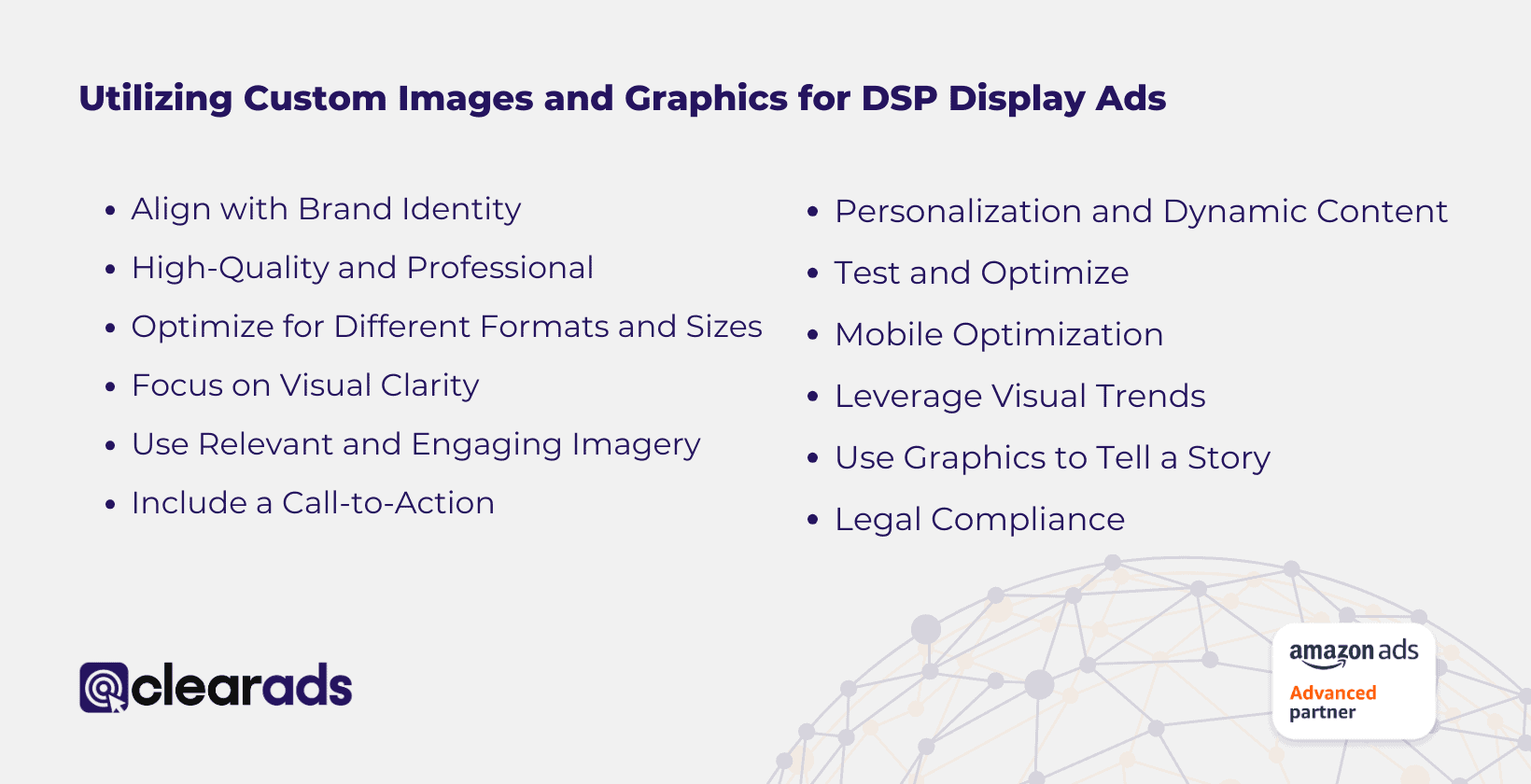
Utilizing custom images and graphics in DSP (Demand-Side Platform) display ads is a critical aspect of creating visually compelling and effective advertising campaigns. Custom visuals can significantly enhance the impact of your ads, making them more engaging and memorable. Here are key strategies and best practices for incorporating custom images and graphics in your DSP display ads:
Align with Brand Identity
Consistency is Key: Ensure that your custom images and graphics align with your brand identity, including colors, fonts, and overall aesthetic. This consistency strengthens brand recognition and trust among your audience.
High-Quality and Professional
Invest in Quality: Use high-resolution, professionally designed images and graphics. Poor quality visuals can negatively impact user perception of your brand and the effectiveness of your ad.
Optimize for Different Formats and Sizes
Adaptability: Create graphics that are adaptable to various ad sizes and formats. DSPs often require multiple ad formats, and your visuals should look great in each one.
Focus on Visual Clarity
Simple and Clear: Avoid cluttered or overly complex images. Your visuals should convey your message clearly and quickly, as users often glance at ads only briefly.
Use Relevant and Engaging Imagery
Resonate with Your Audience: Choose images and graphics that are relevant to your target audience and your product or service. Engaging visuals that evoke emotions or curiosity can improve engagement rates.
Include a Call-to-Action
Visual CTA: Incorporate a clear call-to-action (CTA) within your visuals. Whether it’s a button or text, make it stand out to encourage user interaction.
Personalization and Dynamic Content
Leverage DSP Capabilities: Utilize the DSP’s capabilities to personalize visuals for different audience segments. Dynamic content can significantly increase the relevance and effectiveness of your ads.
Test and Optimize
A/B Testing: Experiment with different images and graphic styles to determine which ones perform best. Continuous testing and optimization are essential for maximizing ad effectiveness.
Mobile Optimization
Mobile-First Approach: Given the high volume of users on mobile devices, ensure that your images and graphics are optimized for mobile viewing, both in terms of size and visual impact.
Leverage Visual Trends
Stay Current: Stay updated with current design trends and incorporate them into your visuals to keep your ads fresh and engaging.
Use Graphics to Tell a Story
Storytelling through Visuals: Use your images and graphics to tell a story about your brand or product. Storytelling can create a deeper connection with your audience.
Legal Compliance
Rights and Permissions: Ensure that you have the appropriate rights and permissions for all images and graphics used. Avoid copyright issues by using original designs or properly licensed stock images.
How to Effectively Use Call-to-Action in DSP Ad Creatives?
Improving the effectiveness of Call-to-Action (CTA) elements in DSP (Demand-Side Platform) ad creatives is essential for driving user engagement and conversions. A well-designed CTA can dramatically influence the success of digital advertising campaigns.
A CTA is a crucial part of the ad that encourages customers to take a specific action. A clear and direct CTA enhances ad performance by setting clear expectations for the landing page experience.
For desktop and Fire device ads, a CTA is mandatory. On mobile, while a CTA is recommended, it’s not obligatory if the ad already clearly conveys the landing page experience.
CTAs should not include end punctuation. If the linked content requires a subscription, this condition must be clearly stated in the CTA or elsewhere in the creative.
In animated ads, the CTA need not be present throughout but must appear in the final frame.
For Amazon ads, the CTA should:
- Be under 30 characters (15 for Japanese).
- Not be used to communicate offers (e.g., “Save $5”).
- Lack end punctuation.
Meet specific placement requirements:
- E-commerce creative: CTAs in custom images are prohibited since the ad design itself suggests the expected customer action.
- Desktop on Amazon: CTAs can be button-style or text-style.
- Mobile on Amazon: If used, CTAs must be clear and actionable, complying with general acceptability policies. Underlined and button CTAs are permitted.
- Off Amazon: All CTA styles are acceptable, provided they comply with acceptability policies.
Key Strategies to Optimize CTAs in DSP Ad Creatives:
- Clarity and Simplicity: Use clear, concise language like “Buy Now”, “Learn More”, or “Sign Up” to communicate the desired action.
- Prominent Placement: Ensure the CTA is easily visible, placed in a spot where it won’t be missed.
- Design That Stands Out: Use contrasting colors to highlight the CTA. Ensure the CTA button is appropriately sized and shaped to be noticeable without overpowering the ad.
- Consistency with Ad Content: Align the CTA with the ad’s message. For example, a CTA for a product discount should relate to purchasing or exploring that product.
- Tailor CTAs to Different Stages of the Customer Journey: Customize the CTA based on the customer’s stage in the buying process, like “Learn More” for awareness stages and “Buy Now” for conversion stages.
- Personalization and Dynamic CTAs: Utilize DSP data to create personalized and dynamic CTAs that adapt to user behavior or demographics.
- Use Action-Oriented Verbs: Start CTAs with verbs like “Discover”, “Start”, “Join”, or “Get” to encourage action.
By applying these strategies, you can significantly improve the impact of your CTAs, leading to increased engagement and conversion rates in your DSP campaigns. Remember, a CTA is more than just a button or text; it’s a strategic element that guides users towards the desired action and is vital for the success of your digital advertising.
Measuring the Impact of Creative Elements on Ad Performance
Measuring the impact of creative elements on ad performance is essential for understanding what resonates with your audience and optimizing your campaigns for better results. Creative elements include aspects like imagery, copy, layout, color schemes, and call-to-action (CTA) buttons. Analyzing how these elements influence ad performance can provide valuable insights into consumer preferences and behavior, ultimately guiding more effective advertising strategies.
5 ways to measure and analyze the impact of creative elements:
1. Establish Key Performance Indicators (KPIs)
- Determine which metrics best reflect the performance of your ads, such as click-through rate (CTR), conversion rate, engagement rate, viewability, or return on ad spend (ROAS).
- It’s important to track how creative elements affect ultimate conversion goals, such as sales, sign-ups, or downloads. This helps in understanding the direct impact on ROI.
- Look beyond basic click-through rates. Analyze engagement metrics like time spent on the ad, interaction rates (for interactive ads), and social sharing metrics, to gauge how effectively your creative elements capture audience interest.
- Utilize the advanced analytics and reporting tools provided by your DSP or third-party analytics platforms to gather detailed data on ad performance.
2. Use A/B Testing
- Implement A/B testing by creating different versions of your ad, each varying in one key creative element. Measure the performance of each version against your KPIs to identify which elements are most effective.
- If you want to understand how different creative elements interact with each other, use multivariate testing. This allows you to analyze the impact of various combinations of creative changes.
3. Audience Feedback
- Direct feedback from your audience through surveys or focus groups can provide insights into how your creative elements are perceived and what might be improved.
4. Monitor Brand Lift
- Evaluate how creative elements impact brand perception and awareness. This can be measured through brand lift studies, which assess changes in consumer awareness, consideration, and preference.
5. Consistent Monitoring and Iteration
- The digital ad landscape is dynamic. Consistently monitor ad performance and iterate on creative elements based on data-driven insights.
- Recognize that external factors like market trends, seasonality, and competitor activities can also impact ad performance.
- Combine insights from creative testing with broader campaign data, such as targeting and placement performance, for a comprehensive understanding.
By systematically measuring and analyzing the impact of creative elements, advertisers can refine their strategies to create more engaging, effective ads. This approach not only enhances the performance of individual campaigns but also contributes to a deeper understanding of brand-audience interactions, fostering long-term advertising success.
Adapting Creative Strategies for Different DSP Audience Segments
Adapting creative strategies for different audience segments in DSP (Demand-Side Platform) advertising is crucial for maximizing the relevance and impact of your campaigns. Audience segmentation allows advertisers to deliver more personalized and effective ads based on specific characteristics, behaviors, and preferences of different groups. Here’s how to tailor your creative strategies for various DSP audience segments:
- Understand Your Audience Segments
Deep Dive into Data: Utilize the data available in your DSP to understand the distinct characteristics of each audience segment. This includes demographics, interests, online behavior, purchase history, and more. - Customize Creative Messaging
Tailored Messaging: Develop ad copy and creative messaging that resonates with the specific needs, interests, and pain points of each segment. Personalized messaging can significantly increase engagement and conversion rates. - Use Relevant Visuals
Segment-Specific Imagery: Choose images and graphics that reflect the lifestyle, preferences, or aspirations of each audience segment. Visual relevance can enhance the connection with the audience. - Segment-Specific Call-to-Action (CTA)
Tailored CTAs: Adapt your CTA based on the segment’s position in the customer journey. For instance, use exploratory CTAs like “Learn More” for top-of-the-funnel segments and more action-oriented CTAs like “Buy Now” for bottom-of-the-funnel segments. - Test Different Creative Formats
Format Variations: Experiment with different ad formats (e.g., video, carousel, static) to see which format resonates best with each segment. - Leverage Dynamic Creative Optimization (DCO)
Automated Personalization: Use DCO to automatically adjust creative elements in real-time based on the user’s characteristics and behaviors. - Reflect Cultural and Regional Nuances
Cultural Relevance: If your segments are based on geographic or cultural lines, ensure your creatives are sensitive to and reflective of local cultural nuances and languages. - Frequency and Timing Adjustments
Segment-Specific Scheduling: Adjust the frequency and timing of your ads based on the segment’s online behavior patterns. Some segments may respond better to ads during specific times of the day or week. - Sequential Messaging for Longer Campaigns
Storytelling Over Time: Use sequential messaging strategies for longer-term campaigns, where the creative narrative evolves with each exposure, leading the segment through a journey. - Monitor and Analyze Performance
Data-Driven Insights: Continuously monitor the performance of your ads across different segments. Analyze metrics like CTR, conversion rate, and engagement to understand what works best for each segment. - Iterate and Optimize
Ongoing Optimization: Use the insights gathered from performance analysis to refine and optimize your creative strategy for each segment over time. - Maintain Brand Consistency
Unified Branding: While personalizing creatives for different segments, maintain a consistent brand voice and identity across all creatives to strengthen brand recognition and trust.
By adapting your creative strategies to the unique characteristics of each audience segment, you can significantly improve the relevance and effectiveness of your DSP campaigns. Personalization, backed by a deep understanding of each segment, is key to creating impactful and engaging ads that resonate with diverse audiences.
Emerging Trends in Ad Creative Design within Amazon DSP
Here are 7 of the latest trends and predictions for ad creative design within Amazon DSP based on current and emerging trends in the industry:
Increased Personalization:
- Leveraging Amazon’s rich consumer data to create highly personalized ad experiences. Ads are increasingly tailored to individual user preferences, browsing history, and purchase behavior.
- There’s a growing trend towards interactive ad formats like polls, quizzes, and swipeable galleries. These formats encourage user engagement, offering a more dynamic ad experience.
- Utilizing DCO for real-time ad customization based on user data and behavior, leading to more relevant and effective ad campaigns.
Short-Form Video Ads:
- Short, compelling video content continues to dominate, driven by user preference for quick and engaging visual stories.
- Video ads are increasingly being used for storytelling and brand messaging.
Simplicity in Visuals: - A shift towards minimalist design, with clean, uncluttered layouts and simple messaging for clearer communication and better user experience.
AR-Enabled Ads:
- The emerging use of AR technology in ads, allows users to visualize products in their environment or engage with the brand in innovative ways.
Eco-Friendly Branding: - With growing consumer awareness around sustainability, brands are incorporating eco-friendly messages and imagery into their ad creatives.
Audio-Enabled Ads:
- With the rise of voice search and smart speakers, there’s a growing trend toward integrating voice and audio elements into digital ads.
Artificial Intelligence in Design:
• Utilization of AI tools for creating and optimizing ad creatives, allowing for more efficient and effective ad production.
These trends reflect the ongoing evolution of consumer preferences and technological advancements in the digital advertising space. Advertisers on Amazon DSP who embrace these trends can create more engaging, relevant, and effective ad campaigns that resonate with modern audiences.
Integrating Brand Storytelling in DSP Ad Creatives
Integrating brand storytelling in DSP (Demand-Side Platform) ad creatives is a powerful strategy to connect with your audience on a deeper level. Storytelling in advertising goes beyond the promotion of a product or service; it involves crafting a narrative that encapsulates your brand’s values, mission, and unique aspects of your products or services.
A step by step guide for how to effectively weave storytelling into your DSP ad creatives:
- Define Your Brand Story
- Understand what your brand stands for. What are its core values? What is its mission? How does it aspire to impact customers and the wider community? Then create a narrative that reflects these values and mission. Your story should be authentic, relatable, and engaging.
- Understand Your Audience
- Tailor your story to resonate with your audience’s values, needs, and aspirations. Use the data available through your DSP to deeply understand your audience segments.
- Use Emotion to Connect
- Good stories evoke emotions. Whether it’s happiness, nostalgia, inspiration, or even a sense of urgency, use emotional triggers to create a connection with your audience.
- Show, Don’t Just Tell
- Utilize visuals effectively to tell your story. This could be through images, videos, or interactive content. Visual elements should complement and enhance the narrative.
- Keep It Consistent Across Channels
- Ensure that your brand story is consistent across all channels and touchpoints. Consistency strengthens brand recognition and reinforces your message.
- Highlight Unique Selling Propositions (USPs)
- Weave your product or service naturally into the story, highlighting its USPs in a way that feels integral to the narrative, not forced.
- Create a Journey
- Good stories have a beginning, middle, and end. Structure your ad creative to take the viewer on a journey, ideally leading them to a call to action.
- Leverage Different Formats
- Depending on your audience and platform, experiment with different formats such as short-form videos, carousel ads, or cinemagraphs to best convey your story.
- Incorporate User-Generated Content
- Where appropriate, integrate user-generated content to add authenticity and relatability to your brand story.
- Optimize for Mobile
- With the prevalence of mobile usage, ensure your storytelling creative is optimized for mobile viewing, both in terms of format and content delivery.
- Test and Iterate
- Continuously test different storytelling elements and use analytics to gain insights into what resonates with your audience. Iterate based on this feedback.
- Add Value
- Your story should add value to the viewer, whether it’s through educating them about a topic related to your brand or simply entertaining them.
Incorporating storytelling into your DSP ad creatives can transform how audiences perceive and interact with your brand. A well-crafted story not only captures attention but also fosters emotional connections, making your brand more memorable and increasing the effectiveness of your advertising efforts.
Challenges in Creative Development for DSP and How to Overcome Them

Creative development for DSP (Demand-Side Platform) advertising presents unique challenges, stemming from the complexities of digital platforms, audience diversity, and the dynamic nature of online advertising. Understanding these challenges and knowing how to overcome them is key to creating successful DSP campaigns.
9 common challenges and strategies to address them:
- Keeping Up with Platform Changes:
- Stay updated by subscribing to relevant newsletters that cover key platform updates.
- Regularly check DSP (Demand Side Platform) resources.
- Engage in industry forums, and attend webinars and training sessions.
- Keep abreast of advertising laws and ensure compliance with copyright and privacy regulations.
- Balancing Creativity and Data-Driven Insights:
- Foster a collaborative dynamic between the creative team and data analysts.
- Use data insights to guide creative decisions while still allowing space for creative innovation.
- Ensuring Creative Relevance Across Diverse Audiences:
- Implement audience segmentation and personalization strategies.
- Create multiple creative variations tailored to different audience segments to enhance targeting.
- Adapting to Different Ad Formats and Sizes:
- Develop versatile creative templates for easy adaptation across various formats.
- Ensure brand consistency is maintained across all ad sizes and formats.
- Managing Creative Fatigue:
- Regularly update and refresh ad creatives.
- Closely monitor performance metrics and rotate creatives to sustain engagement.
- Encourage continuous creativity and experimentation, and stay attuned to current trends.
- Aligning with Brand Guidelines and Voice:
- Establish clear, adaptable brand guidelines.
- Ensure these guidelines accommodate diverse audiences while maintaining a consistent brand identity and voice.
- Optimizing for Mobile Devices:
- Embrace a mobile-first approach in creative development.
- Ensure ads are visually engaging, quick to load, and easily interactive on mobile platforms.
- Measuring Creative Performance:
- Utilize A/B testing and multivariate testing to evaluate the effectiveness of various creative elements.
- Leverage analytics tools from your DSP for in-depth performance insights.
- Managing Resource Constraints:
- Efficiently prioritize and allocate resources.
- Consider automating routine tasks and focus creative energy where it yields the most impact.
By understanding and proactively addressing these challenges, advertisers can create more effective and impactful DSP campaigns. It’s about finding the right balance between creativity, data insights, and operational efficiency to resonate with your target audience while achieving your campaign goals.
